Uzbekistan is a land where the past and present come together in a fascinating blend of culture, history, and adventure. From the ancient cities that once thrived on the Silk Road to its awe-inspiring architectural wonders, this hidden gem offers a wealth of experiences for every traveller.
Uzbekistan, a land steeped in history and culture, offers a truly unique travel experience. From ancient cities along the Silk Road to the grandeur of architectural marvels, this Central Asian gem is a must-see destination for history enthusiasts, adventure seekers, and culture lovers alike.
Whether you're exploring the stunning minarets of Samarkand, shopping in bustling bazaars, or enjoying the warm hospitality of the locals, Uzbekistan guarantees a memorable adventure. This guide will explore the key attractions, local culture, food, and practical tips that make Uzbekistan a must-visit destination.
Geography and climate
Uzbekistan is a landlocked country bordered by Kazakhstan, Kyrgyzstan, Tajikistan, Afghanistan, and Turkmenistan. Its diverse terrain includes deserts, mountains, and fertile valleys.
The Kyzylkum Desert, one of the largest deserts in Central Asia, dominates much of the landscape. The Tien Shan mountains in the east offer breathtaking views and opportunities for hiking and skiing.
The climate in Uzbekistan is continental, characterized by hot summers and cold winters. Summers can be extremely hot, with temperatures often reaching 40°C (104°F) or more. Winters are cold, with temperatures dropping below freezing, especially in the northern regions. Here’s an overview of the climate for each season:
| Season | Average Temperature | Weather Characteristics |
|---|---|---|
| Spring | 15-25°C (59-77°F) | Mild and pleasant |
| Summer | 35-40°C (95-104°F) | Hot and dry |
| Autumn | 10-20°C (50-68°F) | Cool and comfortable |
| Winter | -5-5°C (23-41°F) | Cold and sometimes snowy |
Travelers should prepare for the weather by packing appropriate clothing. Light, breathable fabrics are best for summer, while warm layers are essential for winter. During the hot months, always carry a hat and sunscreen.
Cultural significance
Uzbekistan's culture blends ancient traditions and influences from various civilizations. The country is known for its historical cities, such as Samarkand, Bukhara, and Khiva, which were key points on the Silk Road.
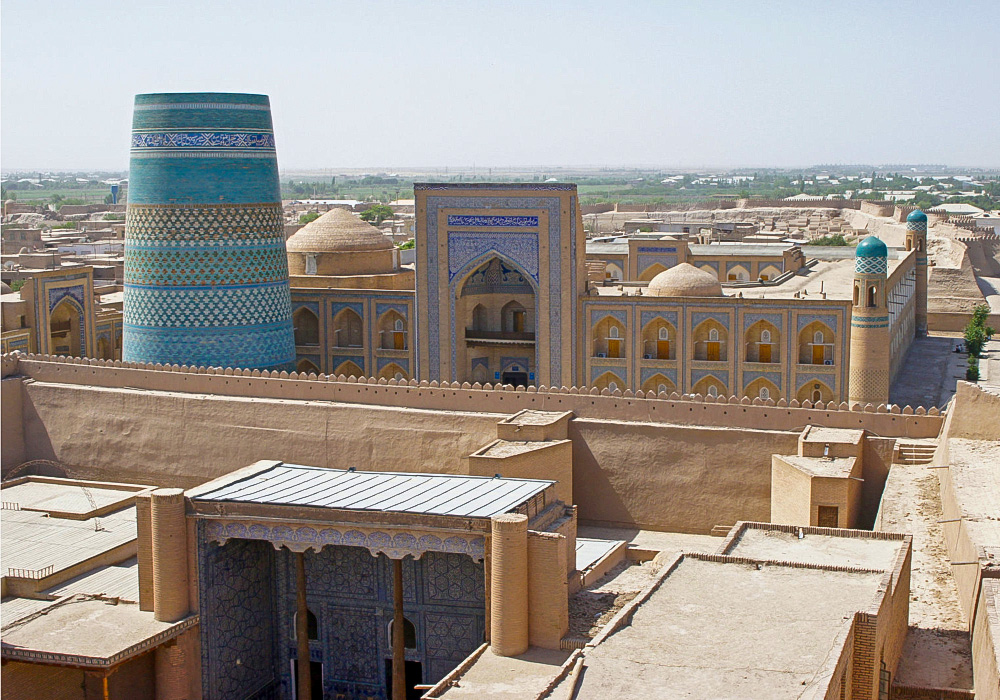
These cities are home to stunning architecture, including mosques, madrasahs, and minarets. The Registan Square in Samarkand is a prime example of Islamic architecture and a UNESCO World Heritage site.
- Language: Uzbek is the official language, but Russian is widely spoken.
- Religion: Islam is the predominant religion, with most people practicing Sunni Islam.
- Festivals: Navruz, the Persian New Year, is a major celebration marking the arrival of spring.
The cuisine of Uzbekistan reflects its agricultural roots, with dishes like plov (rice pilaf), samsa (meat-filled pastries), and lagman (noodle soup) being staples. Fresh fruits and vegetables are also abundant.
Music and dance play significant roles in Uzbek culture. Traditional instruments like the dutar and doira are commonly used in performances. The Shashmaqam, a classical music genre, is deeply rooted in the region's history.
As you mix and mingle, you'll learn that respect for elders, traditional greetings, and modest dressing are essential tenets of the local culture. Understanding Uzbekistan's cultural significance helps travellers appreciate its rich heritage and warm hospitality. Immersing yourself in local traditions and customs will make your visit even more memorable.
Must-visit cities
Uzbekistan offers a rich tapestry of history, culture, and architecture. The country's cities are filled with stunning landmarks, making it a must-visit destination for any traveller. Below are the four must-visit cities in Uzbekistan that should be on your itinerary.
Tashkent
Tashkent, Uzbekistan's capital and largest city, seamlessly blends modern development with traditional charm. As a key hub of Central Asia, it serves as the gateway to the country's rich cultural heritage and history. The city offers a fascinating mix of ancient landmarks, Islamic architecture, Soviet-era structures, and a rapidly developing modern skyline and infrastructure.
Tashkent’s vibrant energy is reflected in its bustling markets, cultural institutions, and scenic parks. The city is home to significant historical sites like the Khazrati Imam Complex, which houses ancient Islamic manuscripts, and the Amir Timur Museum, dedicated to the great conqueror. Visitors can also experience the lively atmosphere of Chorsu Bazaar, where local produce, spices, and handicrafts abound. With its combination of the old and the new, Tashkent is a dynamic city that offers a unique insight into Uzbekistan’s past and present.
- Chorsu Bazaar: A bustling market where local produce, spices, and souvenirs are found.
- Amir Timur Museum: Dedicated to the history and legacy of the great conqueror, Amir Timur.
- Khazrati Imam Complex: Home to ancient manuscripts and religious artifacts.

For a deeper dive into Tashkent's offerings, consider visiting the following:
| Attraction | Description |
|---|---|
| Independence Square | The heart of Tashkent symbolizes freedom and independence. |
| Tashkent Tower | The tallest structure in Central Asia offers panoramic views. |
| State Museum of History | Displays artifacts from Uzbekistan's rich past. |
Samarkand
Samarkand, one of Central Asia's oldest continuously inhabited cities, is a jewel of historical and cultural significance. As a UNESCO World Heritage site, Samarkand stands as a testament to the rich legacy of the Silk Road, once a vibrant crossroads of trade, culture, and ideas between the East and West. The city’s stunning architectural masterpieces, many of which date back to the 14th and 15th centuries, showcase the brilliance of Persian, Mongol, and Islamic influences.
Notable landmarks include Registan Square, a grand ensemble of madrasahs featuring intricate tile work, and Shah-i-Zinda, a stunning necropolis with some of the most beautifully decorated tombs in the region. Gur-e-Amir Mausoleum, the final resting place of the legendary conqueror Amir Timur, adds to the city's historical grandeur. Beyond its architectural splendour, Samarkand offers a glimpse into the history of the Timurid dynasty, with cultural gems like Ulugh Beg Observatory, where the famous astronomer Ulugh Beg once charted the stars. With its deep connection to Central Asia's past, Samarkand invites travellers to step back in time and experience the magic of an ancient civilization.
- Registan Square: A breathtaking ensemble of three madrasahs showcasing Islamic architecture.
- Shah-i-Zinda: A necropolis with intricately decorated tombs.
- Gur-e-Amir Mausoleum: The final resting place of Amir Timur.
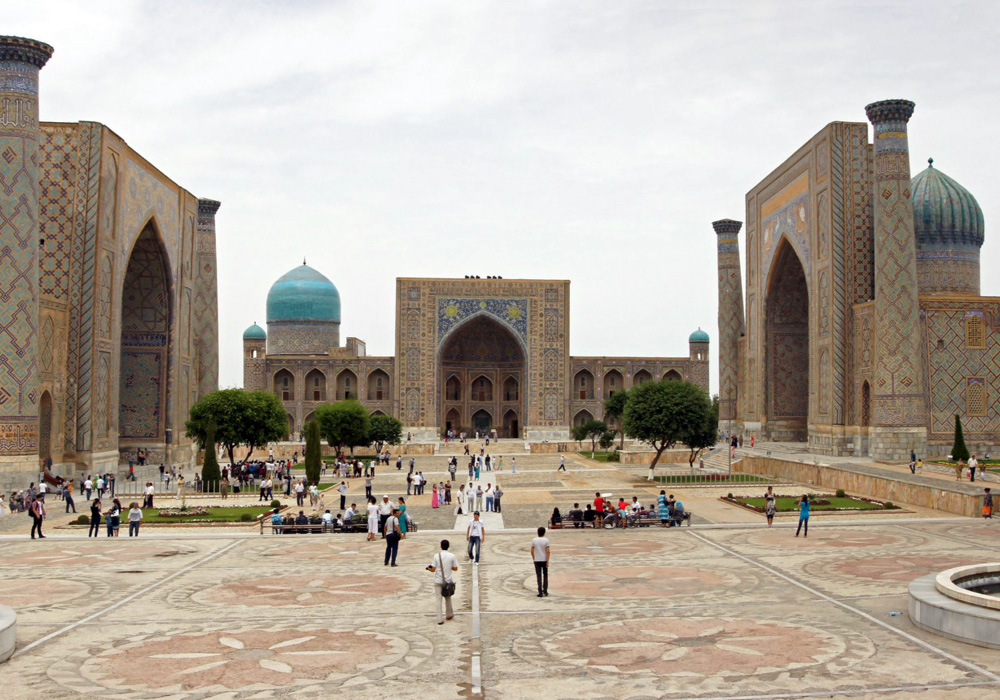
Other must-see locations in Samarkand are:
| Attraction | Description |
|---|---|
| Bibi-Khanym Mosque | It is one of the Islamic world's largest and most magnificent mosques. |
| Ulugh Beg Observatory | An ancient observatory was built by Ulugh Beg, a notable astronomer. |
| Siab Bazaar | A lively market where you can experience local culture and cuisine. |
Bukhara
With over 2,000 years of rich history, Bukhara is one of Central Asia’s most captivating cities. Renowned for its exceptionally well-preserved medieval architecture, Bukhara serves as a living museum, offering visitors an opportunity to step back into a time when it was a thriving hub of trade, culture, and Islamic learning. The city's old town, a UNESCO World Heritage site, is a maze of narrow streets, beautifully adorned historical buildings, and vibrant bazaars that have remained largely unchanged for centuries.
Among its many architectural gems are the majestic Ark Fortress, the ancient citadel that once housed the city’s rulers, and the Po-i-Kalyan Complex, which includes a grand mosque and towering minaret. Lyab-i Hauz, a tranquil plaza surrounding a historic pool, provides a perfect spot to experience the serene charm of Bukhara’s traditional urban design. The city is also home to many madrasahs, caravanserais, and trading domes, where you can shop for exquisite local crafts and textiles. Bukhara’s deep historical significance, combined with its vibrant atmosphere, makes it an essential destination for those eager to explore the heart of Central Asia’s cultural and architectural heritage.
- Ark Fortress: An ancient citadel that served as a residence for Bukhara's rulers.
- Po-i-Kalyan Complex: Featuring a grand mosque and minaret.
- Lyab-i Hauz: A picturesque plaza with a historic pool and surrounding madrasahs.
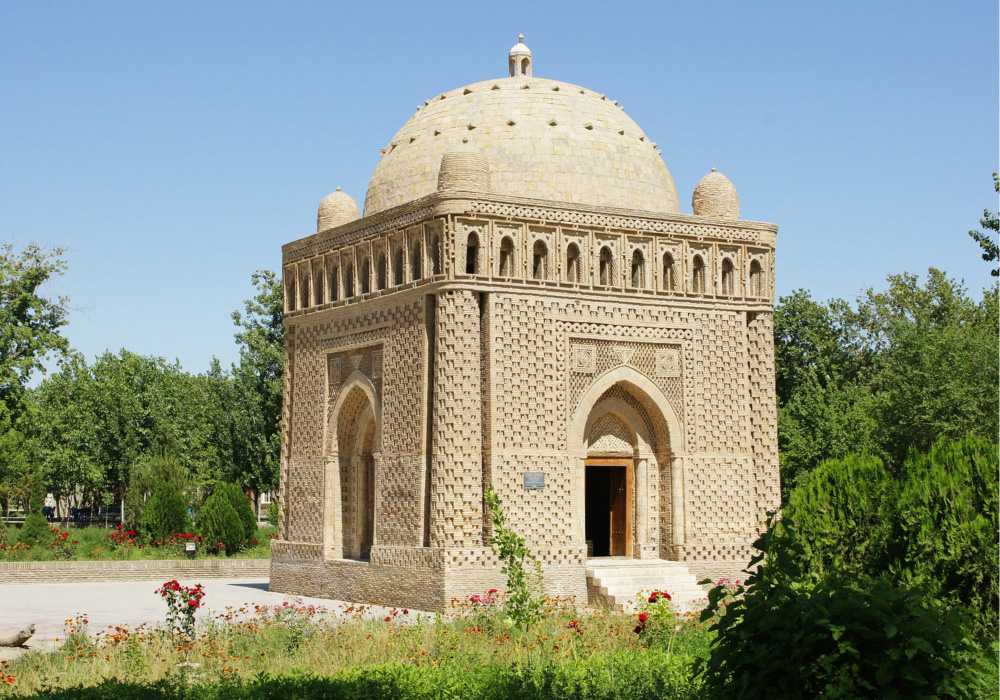
Additional noteworthy sites include:
| Attraction | Description |
|---|---|
| Samanid Mausoleum | A masterpiece of early Islamic architecture. |
| Chor-Minor | A charming structure with four unique minarets. |
| Trading Domes | Ancient bazaars where you can shop for traditional crafts. |
Khiva
Khiva is a historic city in western Uzbekistan, renowned for its well-preserved ancient architecture and rich history. As a UNESCO World Heritage site, its Old Town, Ichan Kala, is an exceptional example of Silk Road heritage. The walled city is home to stunning madrasahs, mosques, and palaces, offering a unique glimpse into the past.

Notable attractions include the Kalta Minor Minaret, famous for its vibrant blue tiles, and the Kunya Ark Citadel, a former royal residence now housing a museum. The Juma Mosque, with its 218 carved wooden columns, and the Tash Khauli Palace, with its intricate tilework, are also must-sees.
Khiva’s charm lies in its untouched architecture and serene atmosphere, making it an essential stop for history and culture enthusiasts looking to experience the rich legacy of the Silk Road.
- Ichan Kala: The walled inner city, home to grand madrasahs, mosques, and palaces.
- Kalta Minor Minaret: Known for its vibrant blue tiles, this minaret is one of Khiva’s most iconic landmarks.
- Kunya Ark Citadel: A former residence of Khiva’s rulers, it now serves as a museum.
Local cuisine
Uzbekistan, located in the heart of Central Asia, is a gem for travellers. One of the highlights of visiting this country is its rich and diverse local cuisine. Uzbek food is a melting pot of flavours, influenced by the many cultures that have passed through this ancient land. Every meal is an adventure, from hearty traditional dishes to delightful street food.
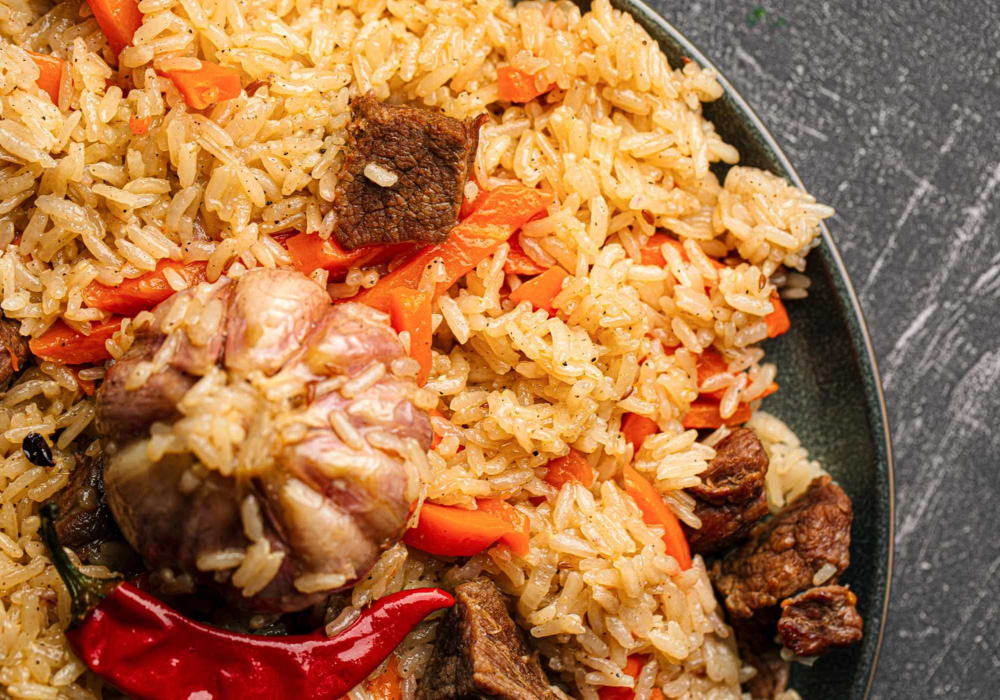
Traditional dishes
Uzbekistan's traditional dishes are a true reflection of its history and culture. These dishes are often prepared with love and passed down through generations. Here are some must-try traditional dishes:
- Plov: This is Uzbekistan's national dish. Made with rice, meat (usually lamb), carrots, and onions, it's cooked slowly to absorb all the flavors. A special occasion or gathering is incomplete without Plov.
- Shashlik: These are skewered and grilled meat pieces, often served with onions and flatbread. They can be made from lamb, beef, or chicken.
- Manti: Steamed dumplings filled with minced meat and onions. They are usually served with sour cream or a tomato-based sauce.
- Lagman: A noodle soup with meat, vegetables, and sometimes a spicy broth. It's hearty and perfect for colder days.
Street food delights
Street food in Uzbekistan is vibrant and full of flavours. Walking through the bustling streets, you'll find vendors offering a variety of quick bites. Here are some street food favourites:
- Somsa: These are pastry pockets filled with meat, onions, and sometimes pumpkin or potatoes. They are baked in a tandoor oven, giving them a crispy exterior.
- Chuchvara: Small dumplings, similar to Manti but bite-sized. They are often boiled and served with broth or yogurt.
- Naryn: A cold dish made of hand-pulled noodles mixed with horse meat. It's seasoned with spices and usually enjoyed on-the-go.
- Patir: A type of flatbread, often topped with sesame or poppy seeds. It's perfect for snacking while exploring the city.
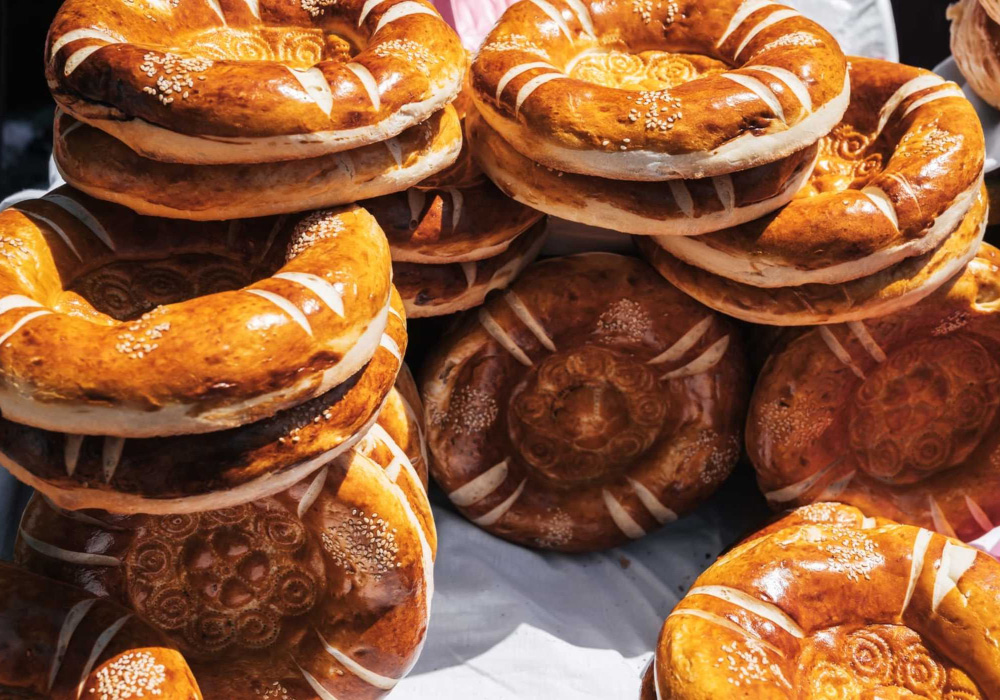
Enjoying these street foods is an essential part of experiencing Uzbekistan. Each bite tells a story of the country's rich culinary heritage.
Historic sites
Uzbekistan is a land of ancient wonders. This country in Central Asia is rich in history and culture. Historic sites offer a glimpse into the past, revealing stories of empires, traders, and travellers. Let's explore two must-see historic sites in Uzbekistan.
Registan Square
Registan Square is in Samarkand. It is one of the most famous landmarks in Uzbekistan. This square was the heart of the ancient city, a place for public gatherings, royal proclamations, and celebrations.
Three grand madrasahs surround Registan Square:
- Ulugh Beg Madrasah: Built in the 15th century, it was a center of learning.
- Tilya-Kori Madrasah: Built in the 17th century, it also served as a mosque.
- Sher-Dor Madrasah: Known for its tiger mosaics.
The architecture of these buildings is stunning. You will see intricate tile work, grand archways, and beautiful mosaics. The blue and gold colours add to the magnificence.
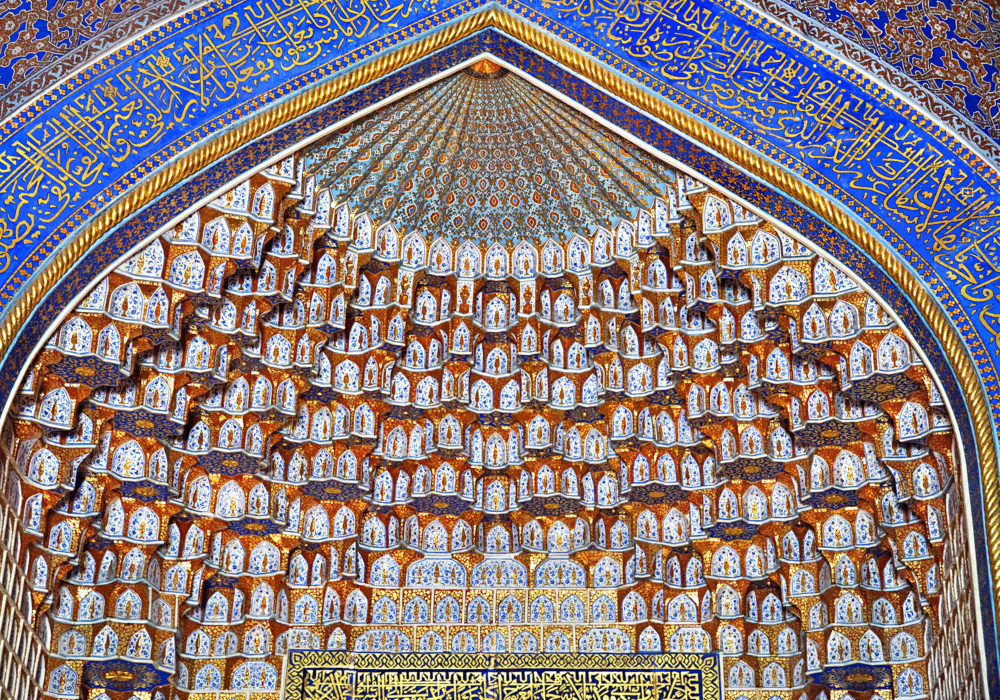
Here is a quick look at the madrasahs:
| Madrasah | Year Built | Unique Feature |
|---|---|---|
| Ulugh Beg Madrasah | 15th Century | Astronomy and science center |
| Tilya-Kori Madrasah | 17th Century | Golden interior |
| Sher-Dor Madrasah | 17th Century | Tiger mosaics |
Registan Square is a symbol of Samarkand's rich history. Visiting this square is like travelling back in time. It's a must-see for anyone interested in history and architecture.
Shah-i-zinda
Shah-i-Zinda is another historic site in Samarkand. The name means "The Living King." This site is a necropolis, a city of the dead, with a collection of mausoleums and tombs.
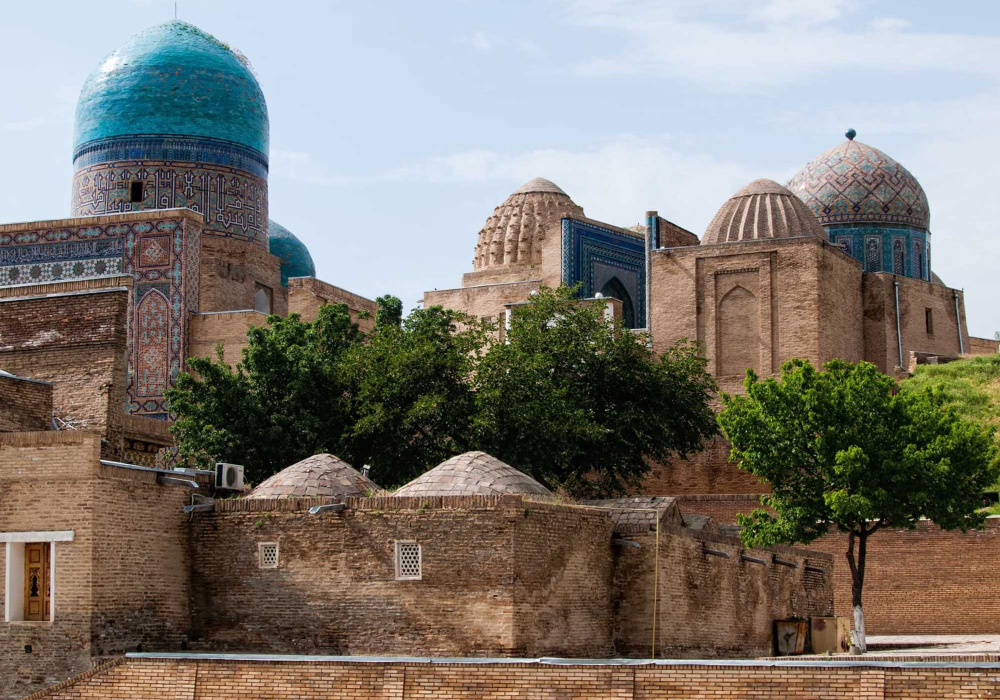
The site dates back to the 9th century and has been expanded over the centuries. Many of the tombs belong to royal families and nobles. The most famous tomb is that of Qusam ibn Abbas, a cousin of Prophet Muhammad.
Shah-i-Zinda is known for its beautiful tile work and architecture. The blue tiles are a signature of Samarkand. The patterns and designs are intricate and detailed.
Here are some key features of Shah-i-Zinda:
- Qusam ibn Abbas Mausoleum: The most revered tomb.
- Shadi Mulk Mausoleum: Known for its stunning blue tiles.
- Octagonal Tomb: Unique shape and design.
Shah-i-Zinda is a peaceful and spiritual place. It offers a glimpse into the history and culture of Samarkand. Walking through the site, you can feel the history around you. The beauty and serenity of Shah-i-Zinda make it a special place to visit.
Travel tips
To make the most of your trip to Uzbekistan, keep these travel tips in mind:
The best time to visit
The best time to visit Uzbekistan is during spring and autumn when the weather is most favourable for outdoor activities and sightseeing. These seasons offer moderate temperatures, blooming flowers, and beautiful greenery, making it ideal for exploring the country. Spring brings vibrant landscapes, while autumn showcases a harvest season with fresh fruits.
In contrast, summer temperatures can soar above 40°C (104°F), making outdoor exploration less comfortable. Winter can bring cold conditions, especially in the northern regions. To make the most of your trip, it’s recommended that you plan your visit during the milder months.
| Season | Temperature Range | Highlights |
|---|---|---|
| Spring | 15-25°C (59-77°F) | Mild temperatures, blooming flowers, greenery |
| Summer | 35-40°C (95-104°F) | Hot and dry, less ideal for outdoor activities |
| Autumn | 10-20°C (50-68°F) | Cool, perfect for sightseeing, harvest season |
| Winter | -5-5°C (23-41°F) | Cold, especially in the north, ideal for indoor visits |
Accommodation options for travellers
Uzbekistan provides diverse accommodation options, catering to all types of travellers. Whether you're seeking luxury or a budget-friendly stay, there’s something for everyone. High-end hotels offer world-class amenities, while affordable hostels provide an excellent base for travellers on a budget. For a more authentic experience, consider staying in traditional guesthouses or homestays, which allow you to immerse yourself in the local culture and hospitality.
| Accommodation Type | Example Hotels | Description |
|---|---|---|
| Luxury Hotels | Hyatt Regency Tashkent, Lotte City Hotel Tashkent Palace | High-end accommodations with top-tier amenities |
| Mid-Range Hotels | Hotel Uzbekistan, Shodlik Palace, Samarkand Plaza | Comfortable hotels offering a balance of value and comfort |
| Budget Hotels and Hostels | Hotel Malika Bukhara, Hostel Laliopa, Topchan Hostel, Art Hostel | Affordable options for budget-conscious travelers |
| Authentic Experiences | Traditional Guesthouses and Homestays | Experience local culture and hospitality in a more intimate setting |
Whether you're after luxury, comfort, or cultural immersion, Uzbekistan's wide range of accommodations ensures a memorable stay.
Souvenirs and shopping
A trip to this Central Asian gem is incomplete without indulging in some delightful shopping. From bustling local markets to exquisite handcrafted goods, Uzbekistan offers a variety of unique souvenirs that capture the essence of its heritage.
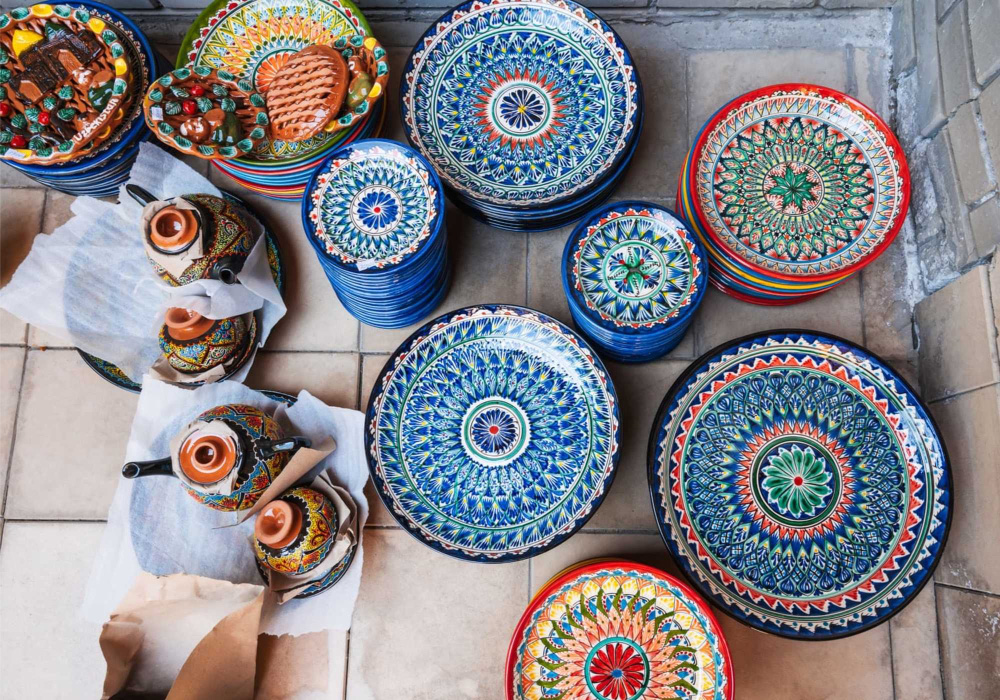
Local markets
Exploring local markets in Uzbekistan is an unforgettable experience. These markets are brimming with energy, colours, and aromas. They provide a glimpse into the daily life of the locals.
Some popular markets you should visit:
- Chorsu Bazaar (Tashkent): One of Tashkent's oldest and largest markets. You can find fresh produce, spices, textiles, and traditional clothing here.
- Siab Bazaar (Samarkand): Famous for its dried fruits, nuts, and sweets. It's the perfect place to buy authentic Uzbek delicacies.
- Khiva Bazaar (Khiva): Located near the historic Itchan Kala. Offers a range of souvenirs, including ceramics, carpets, and local crafts.
- Alay Bazaar (Fergana Valley): Known for its vibrant atmosphere and diverse range of goods. You can purchase everything from pottery to traditional musical instruments.
Shopping tips for local markets:
- Bargain: Haggling is common and expected. Don't hesitate to negotiate the price.
- Cash is King: Many vendors prefer cash payments. Ensure you have enough local currency.
- Early Bird: Visit the markets early in the morning for the best selection and fewer crowds.
Handcrafted Goods
Uzbekistan is renowned for its exquisite, handcrafted goods, which tell a story of the country's rich cultural heritage.
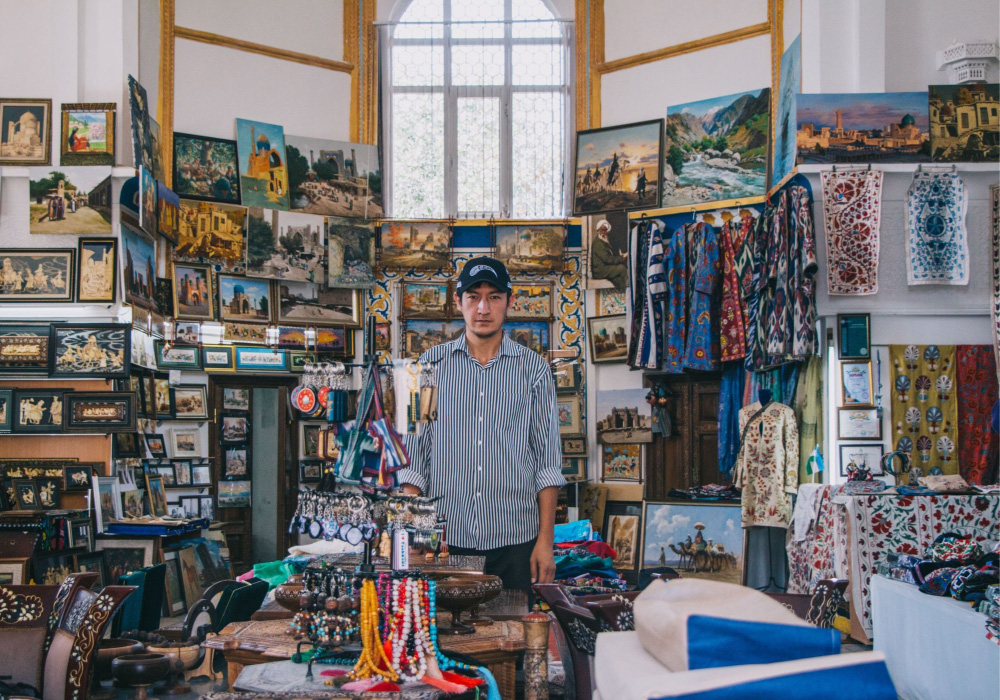
Must-buy handcrafted items include:
- Ceramics: Uzbekistan's ceramics are famous for their intricate designs and vibrant colours. The town of Rishtan is particularly known for its stunning pottery.
- Carpets: Handmade carpets and rugs are a symbol of Uzbek craftsmanship. Each piece is unique and takes months to create.
- Silk: The silk of Margilan is world-famous. You can buy silk scarves, garments, and ikat fabrics that are both beautiful and lightweight.
- Woodwork: Uzbekistan's wooden carvings are intricate and detailed. Items like jewelry boxes, chess sets, and door panels make for lovely souvenirs.
- Embroidery: Suzani embroidery is a traditional Uzbek art form. These embroidered textiles are often used as wall hangings, bedspreads, or tablecloths.
Uzbekistan is a land of rich culture, fascinating history, and incredible landscapes. Whether you’re wandering through ancient Silk Road cities, savouring the flavours of traditional Uzbek cuisine, or exploring the natural beauty of the desert and mountains, this country offers an unforgettable adventure. Uzbekistan's unique blend of tradition and modernity invites you to immerse yourself in its heritage and charm. Start planning your journey to this captivating destination today and experience the magic of Central Asia.
Safe travels, and enjoy discovering Uzbekistan!

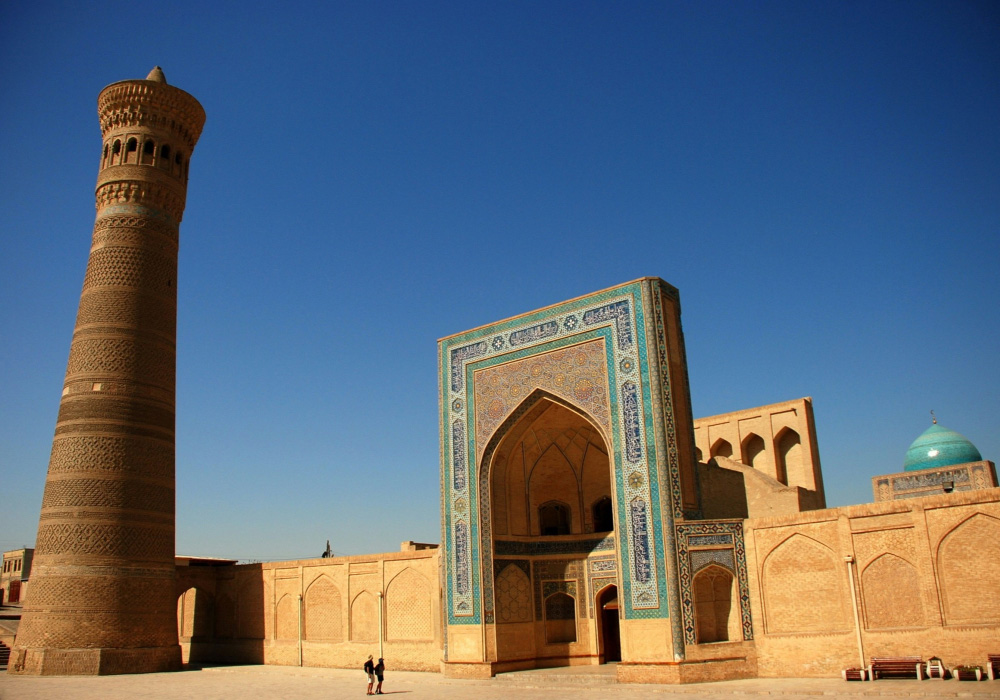


Comments powered by CComment